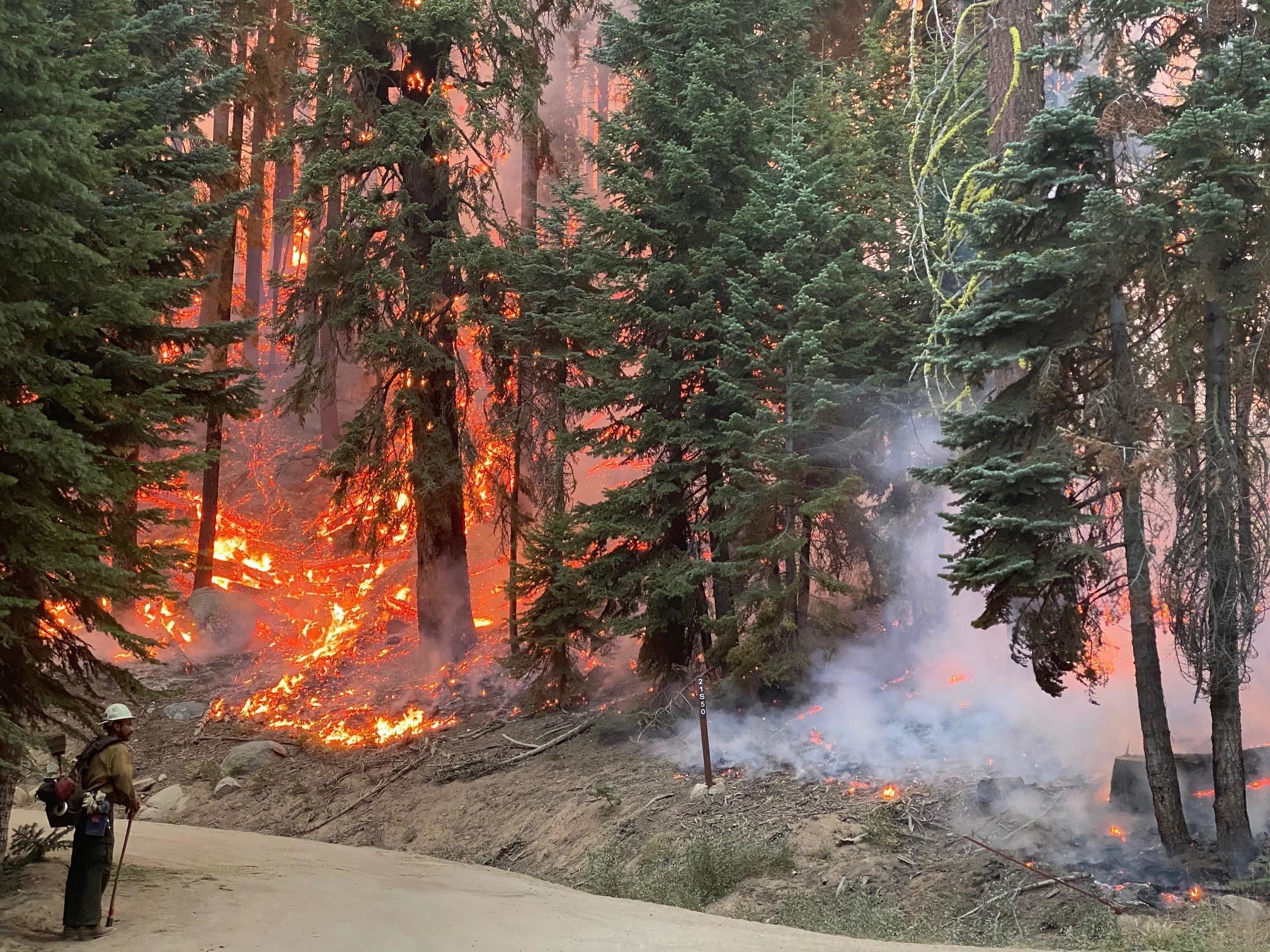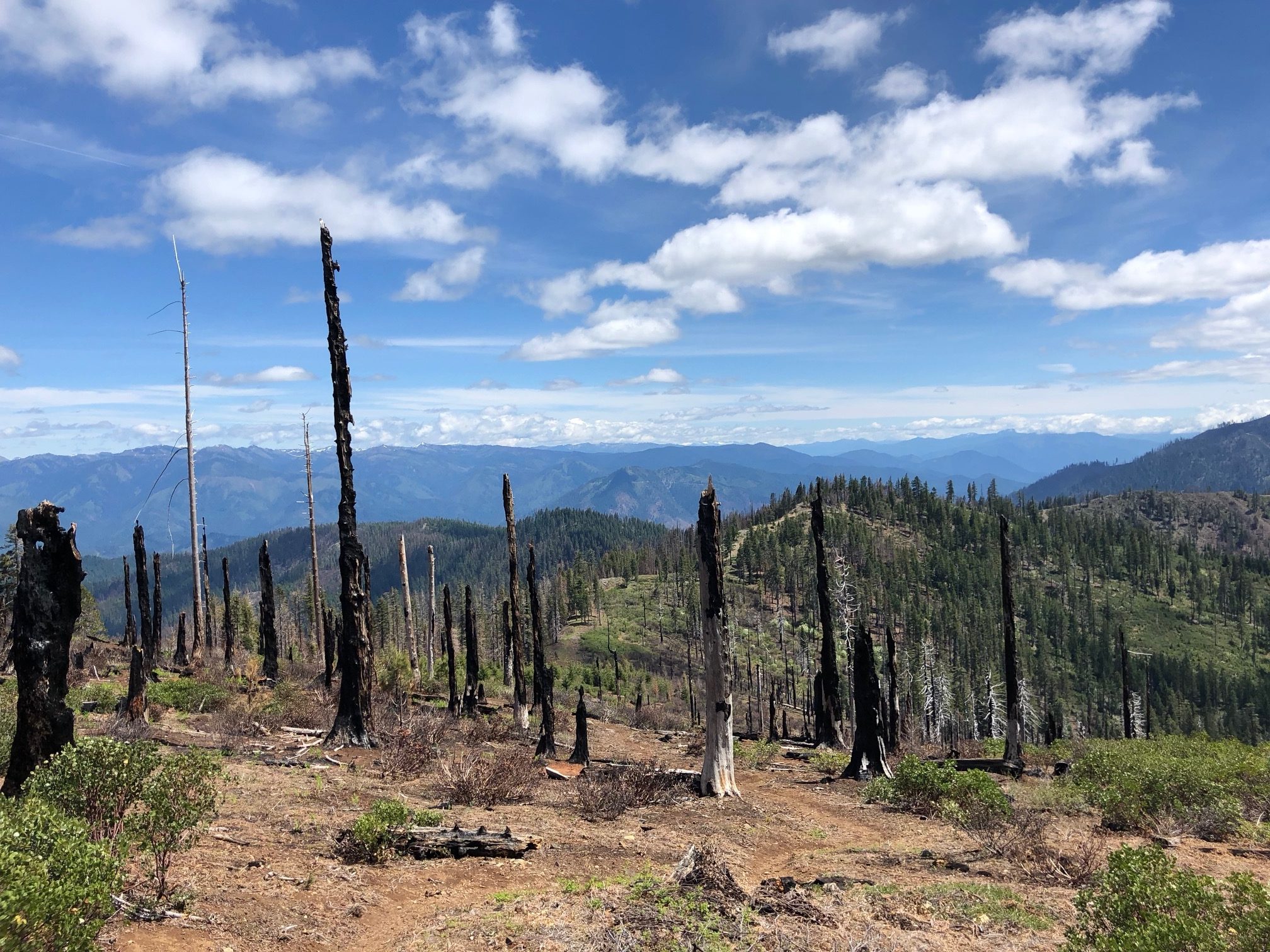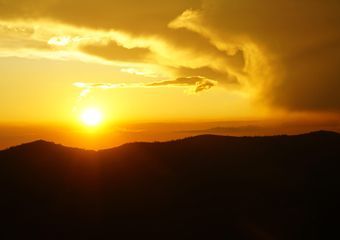Why Are the 2020 Wildfires so Bad, and How Will They Affect the PCT?
The American West is burning—but then, you probably already knew that. Even if you’re not one of the millions who currently live in eerie, red, smoke-darkened proximity to the flames (or beneath the ever-expanding smoke plume that’s now blanketing much of North America and the Atlantic Ocean), you’ve probably read about the infernos in the news. This year’s blazes are making plenty of headlines. Why are the 2020 wildfires so bad, and what will they mean for the PCT community?

Sky overlooking Davenport during the CZU August Complex fire. Photo by Mike Chiodini, BLM.
Are the 2020 Wildfires Really that Much Worse than Normal?
Yes. Both the extent of burned acreage and the proximity of many fires to population centers is unprecedented—particularly in California and Oregon. Nationally, some seven million acres have burned so far in 2020, according to the National Interagency Fire Center. That’s less acreage than in some recent years by this date, but it’s more than the annual average of 5.6 million acres burned to date between 2010 and 2019.
According to Cal Fire, a record-breaking 3.6 million acres have burned so far this year in California alone. (For reference, just over a million acres burned on average each year between 2015 and 2019 in the state). And fire season is far from over. It typically lasts until late October, but this year might be prolonged through the end of November due to the formation of a La Ninã climate pattern that’s expected to bring more hot, dry weather to the region.

View of the 2020 Lionshead Fire in Oregon. Photo via Sydney Brehm.
The total area burned to date tells only part of the tale. The fact that so many large fires are burning simultaneously is also highly unusual. Five of the largest California wildfires of the past 10 years are burning right now. One of them, the gargantuan August Complex, is the largest in state history at 878,368 acres (as of this writing). As a result, firefighting and emergency responder resources have been spread dangerously thin.
Also, an unprecedented number of fires are threatening major population centers this year. Whenever blazes come close to human infrastructure, the stakes get dramatically higher. The fires have affected millions of people through unhealthy air quality and forced evacuations. Thousands of structures have been destroyed or damaged and at least 37 people have died. By one estimate, the fires could cost $20 billion in direct damages alone.
Why Are the 2020 Wildfires so Bad?

Fire behavior along the fire’s north flank of the August Complex North Zone. Forest Service photo by Mike McMillan.
A combination of climate change, historic land management and fire suppression tactics, freak weather events, and human error has lead to this year’s massive infernos. These factors are all inextricably linked.
Highly unusual lightning storms started some of the 2020 wildfires. Others were started by humans. The 22,600-acre El Dorado fire, for example, was ignited by fireworks from a gender reveal party. But while weather and people might have provided the initial spark, climate change and centuries of bad fire suppression tactics set up the conditions that allowed this year’s fires to rage out of control.
Climate Change
The 2020 wildfires are part of a disturbing trend of escalating fire size and intensity in recent years. This pattern can be explained, at least in part, by a shift toward hotter, drier weather due to the climate crisis.
Much of the west has been in the throes of a severe megadrought for the past 20 years. Although 2019 was an unusually high snow year, 2020 was one of the lowest in state history.
It’s also getting hotter. Average temperatures in the state have crept up by about three degrees in the past 100 years. This year’s intense August heatwave, which saw the mercury top a sweltering 130˚F in Death Valley, has only served to further desiccate soil and vegetation. These hot, dry conditions are fertile grounds for intense burns.

Fire in Sequoia National Forest-SQF Complex. Photo by US Forest Service.
Fire Suppression
Our country’s historic approach to wildland firefighting has been, to the extent that it’s possible, to prevent fires from burning altogether, and to completely eliminate any fires that do ignite. As more and more people have settled in some of the country’s most fire-prone environments, the need to completely suppress fires has grown in order to protect human lives and infrastructure.
Unfortunately, this strategy ignores the fact that fire is a natural and necessary element of many ecosystems, including much of the arid West. And messing with any aspect of a complex system is sure to have repercussions felt throughout that system.
When allowed to burn naturally, fires reduce overcrowding in forests. This limits the spread of infectious diseases between trees that could lead to mass die-off and an influx of deadwood kindling. The Creek Fire in the Sierra Nevada, for instance, has been exacerbated by heavy beetle kill in the area (and beetle kill, in turn, has been exacerbated by unusually warm winters attributed to climate change).
Fires also stimulate some plant species to germinate and allow sunlight to reach the forest floor, feeding a whole community of flora and fauna. They consume dead wood and debris on the forest floor, recycling nutrients into the soil and preventing fuel from accumulating year after year.

Siskiyou Wilderness, summer 2018. Photo by Lenya Quinn-Davidson.
But when fires are suppressed for years, trees grow in close together and deadfall piles up. That leaves woodlands prone to go up like a bonfire in response to a random lightning strike, a spark from a malfunctioning power line, or a cigarette tossed carelessly aside.
Flames that might have just smoldered slowly in the undergrowth under normal circumstances can instead climb high in the trees and grow into a hot, fast-spreading crown fire that obliterates forests and sterilizes the very soil they root in.
What Happens Next?

Prescribed burn on the north coast of California, fall 2018. Photo by Lenya Quinn-Davidson.
Unfortunately, climate change is now the reality of our present and at least our short-term future. Although scientists believe the effects of climate change are still reversible at this point, we will still see the adverse effects of global heating for decades to come, even with immediate, robust climate action.
We need to enact meaningful global policies to dramatically reduce emissions and sequester CO2 and other greenhouse gases without delay so that climate change doesn’t spiral completely out of control. Our window of opportunity is shrinking fast.
In the near term, we can implement strategies to address the worsening problem of wildfires. Most importantly, we can treat more woodlands with selective thinning and prescribed burns to reduce fuel accumulation in forests. Fires burning in remote areas that pose no threat to human lives or infrastructure should also be allowed to run their course.
California would need to burn or thin up to 20 million acres, a fifth of the state’s land area, to reverse the cumulative effects of historic fire suppression. This is no mean feat: doing so would require massive funding, manpower, and public-private partnership.
What About the Pacific Crest Trail?
“We’ve got about eight fires that crossed the trail and 90 miles of trail within those eight fires,” said Mark Larabee, associate director of Advocacy and Government Relations with the Pacific Crest Trail Association (PCTA).
The fire situation is continuing to evolve, and with the blazes ongoing, PCTA crews can’t get out to the trail to assess the extent of the damage yet. “It’s really hard to say with certainty, even if the trail is inside a fire perimeter, that it burned.”
Larabee said the extent of fire closures on the trail this year is highly unusual. “It’s a very unprecedented year when the Forest Service closes most of the forest in two states. We have 1,800 miles out of 2,650 miles… off-limits.” Some California forests are starting to reopen in various degrees. Stoves and open flames are still banned statewide.
Once the fires abate, crews of volunteers will be able to do an assessment of trail damage and make repairs where necessary. “All our volunteers are champing at the bit to get out there and do the work that they love doing, but we’re just not able to get them out quite yet because we want to keep them safe, both from fire and from the pandemic.”
COVID-19 and the 2020 Wildfires
COVID-19 has curtailed trail maintenance efforts all year, resulting in a backlog of ongoing repair work. The pandemic has also hampered firefighting and emergency response efforts to the 2020 wildfires as agencies strive to protect workers and volunteers from the pandemic.
“We’re really concerned about the communities that have seen homes burn,” said Larabee. “A lot of those communities are where our volunteers live. We don’t know how they’re doing yet.
“We’re concerned about all the folks that lost their homes, and our hearts go out to the people that have died and their families.”
The long work of repairing fire damage will begin when it’s safe for trail crews to return to the PCT. “We’ll likely see a multiyear effort from this, but this is just ongoing work for us,” said Larabee. “We’re still working on fires from two years ago and trying to keep the trail open.”
The nature of the work will depend largely on the extent of the damage, but common trail maintenance tasks following a wildfire include clearing landslides and fallen trees and shoring up stretches of trail that are increasingly at risk of erosion. “ is always trying to take the trail back from us, and we’re always putting it back in.”
Larabee emphasized that while the human cost of wildfires can be devastating, fires are “often a restorative force for Mother Nature… In a few years, we’ll see those places that burned transform and revitalize themselves because of fire.”
How Can You Help?
Larabee encouraged concerned citizens to “give to the places that are doing great things to try to help.” He provided the following list of charities helping communities in PCT states:
- American Red Cross
- United Way of Northern California
- United Way of Whitman County
- United Way of Jackson County
- Center for Disaster Philanthropy
- California Fire Foundation
- Salvation Army
- Wildland Firefighter Foundation
- Direct Relief
- Save the Children
- VEMAnet (Volunteers for the Emergency Management of Animals Network)
“Of course we’re going to be needing their help as well. We need people to volunteer to get out on our crews once we’re up and running.” Donations to PCTA are also much appreciated and will go a long way toward funding trail repairs. “We’ll… need funds to marshal those volunteers and bring supplies, buy tools, gas money, and everything else that it takes to get out to those places and get the work done.”
Hikers should wait for closed sections of trail to officially reopen before heading back out. Always respect local fire restrictions and observe Leave No Trace guidelines to minimize campfire impacts. When traveling through burned areas, keep to the trail to avoid creating further erosion on unstable slopes and be on the lookout for hazard trees over the trail.
Featured image: View of the 2020 SQF Complex in Sequoia NF. Photo by US Forest Service.
This website contains affiliate links, which means The Trek may receive a percentage of any product or service you purchase using the links in the articles or advertisements. The buyer pays the same price as they would otherwise, and your purchase helps to support The Trek's ongoing goal to serve you quality backpacking advice and information. Thanks for your support!
To learn more, please visit the About This Site page.






Comments 3
Incredible work and research Kelly!! Such an important topic
Weren’t most of the current Cali fires started by rather rare “dry lightning” strikes?”